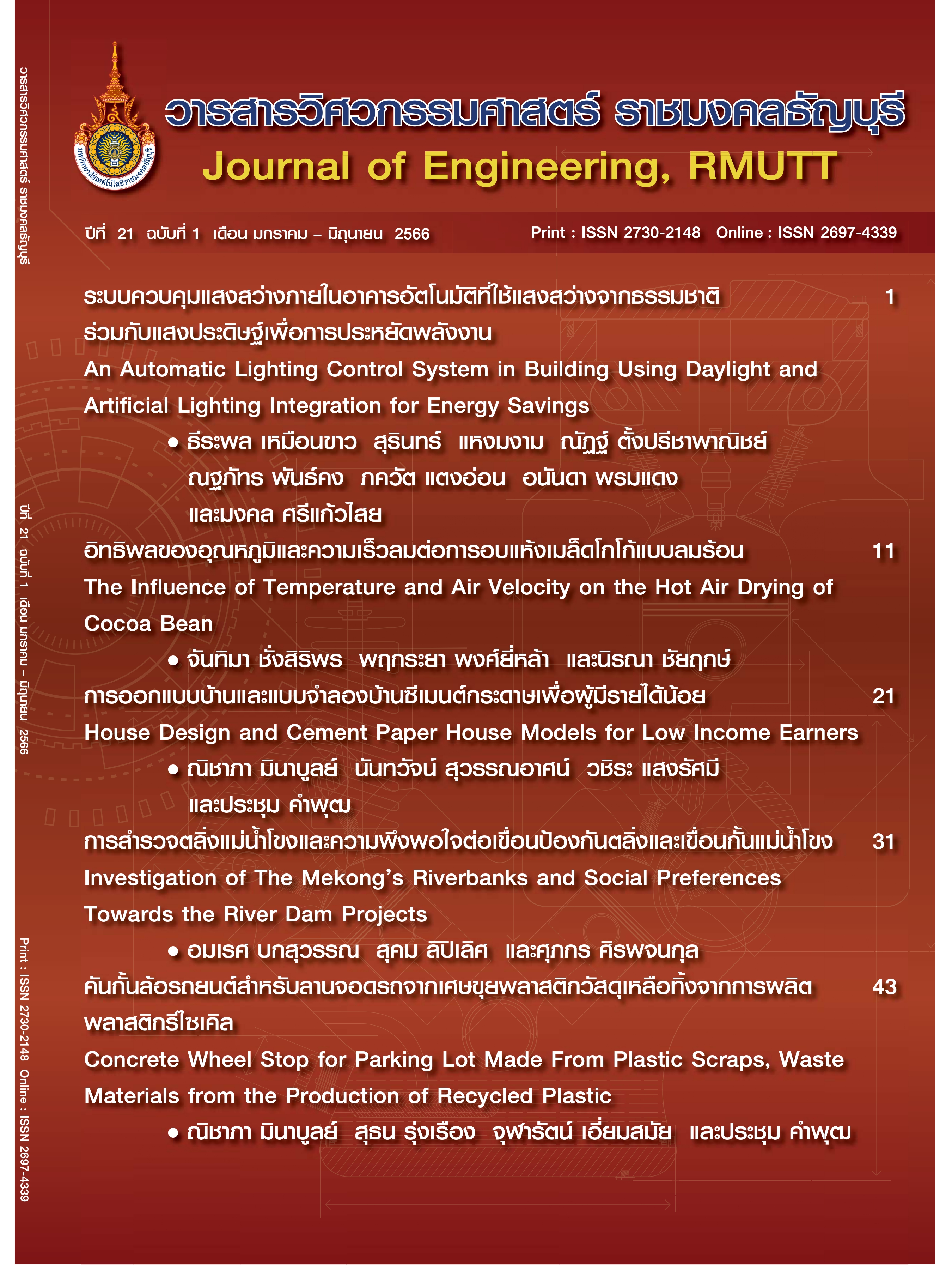The Influence of Temperature and Air Velocity on the Hot Air Drying of Cocoa Bean
Main Article Content
Abstract
The objective of this research was to investigate the effects of drying parameters on drying time and specific energy consumption of cocoa beans drying. The drying temperature of 50, 60, 70 and 80oC and air velocities of 0.05, 0.067, 0.085 and 0.1 m/s were studied. Amount of cocoa bean placing on drying tray at 1 and 2 layers were monitored. The moisture ratio, drying rate and energy consumption were analyzed. The results showed that the drying time decreased as the drying temperature and the air velocity increased. The optimum condition for drying cocoa beans was at 60oC with air velocity of 0.1 m/s at 1 layer of bean drying. The drying time of 130 min, which was the lowest energy consumption condition as the specific energy consumption of 74 MJ/kg water evaporated. The Midilli et al. model was an equation that predicts the optimum reduction of cocoa bean moisture. The highest decision coefficient (R2) and the lowest RMSE, and SSE with R2 greater than 0.9964 RMSE and SSE value were 0.01774 and 0.000913, respectively. These results can be used as a guideline for further development of cocoa bean drying quality.
Article Details

This work is licensed under a Creative Commons Attribution-NonCommercial-NoDerivatives 4.0 International License.
The manuscript, information, content, picture and so forth which were published on Frontiers in engineering innovation research has been a copyright of this journal only. There is not allow anyone or any organize to duplicate all content or some document for unethical publication.
References
Chotinan N. Cocoa, an alternative crop of the future. Technology Chaoban [Internet]. 2021 [cited 2021 Feb 9]. Available from : https://www.technologychaoban.com/bullet-newstoday/article_171743. Accessed 21 February 2021. (in Thai)
Rakitikul W, Sirita J, Yodsuntorn P, Changruanngam T, Nanglae S. Chemical composition analysis to determine the identity of cocoa in Chiang Rai province. Journal of KPRU Science Mathemayics and Technology. 2022;1(1):19-34. (in Thai)
Maskan M. Microwave/ air and microwave finish drying of banana, Journal Food Engineering. 2000;44:71-8.
Asavarachan R. Drying agricultural products by microwave. Kasem Bundit Engineering Journal. 2021;1(2):31-42
Pérez-Marín J, Garrido-Mesa J, García-Sánchez F. Changes in color and phenolic content of cocoa seeds during roasting. Journal of agricultural and food chemistry. 2009;57(17):7899-906.
Karam M.C, Petit J, Zimmer D, Baudelaire Djantou E, Scher J. Effects of drying and grinding in production of fruit and vegetable powders: A review. Journal of Food Engineering. 2016;188:32-49.
Orikasa T, Wu L, Shiina T, Tagawa A. Drying characteristics of kiwifruit during hot air drying. Journal of Food Engineering. 2008;85:303-8.
Saniso E, Saudi F, Hanafee R. Moisture diffusivity coefficient specific energy consumption and specific moisture extraction rate of betel nut drying using combined thermal energy. Burapha Science Journal. 2012;17(1):142- 9.
Kar A. Gupta D.K. Air drying of osmosed button mushroom. Journal of Food Science and Technology. 2003;40(1):23-7.
Farla J, Blok K, Schipper L. Energy efficiency developments in the pulp and paper industry. Energy Policy. 1997;25:745–58.
Kumar P.G.D, Hebbar H.U, Ramesh M.N. Suitability of thin layer models for infrared-hot-air-drying of onion slices. LWT – Food Science and Technology. 2006;39:700-5.
Zhang Q, Litchfield J. An optimization of intermittent corn drying in a laboratory scale thin layer dryer. Drying Technology. 1991; 9(2):383- 95.
Togrul IT, Pehlivan D. Mathematical modelling of solar drying of apricots in thin layers. Journal of Food Engineering. 2002;55(3) :209-16.
Henderson S. Progress in developing the thin layer drying equation. T ASAE. 1974;17(6):1167-8.
Midilli A, Kucuk H, Tapar Z. A new model for single layer drying. Drying Technology. 2002;20(7):1503-13.
Nagaya K, Li Y, Jin Z, Fukumuro M, Ando Y Akaishi A. Low-temperature desiccant based food drying system with airflow and temperature control. Journal of Food Engineering. 2006;75:74-7.
Barthakur N.N, Arnold N.P. Evaporation rate enhancement of water with air ions from a corona discharge. International Journal of Biometeorology. 1995;39:29-33.
Vongsawasdi P, Noppharatana M, Jiranuntakul W, Vinuntamalakul T. Sitiworapong S. Effect of temperatures and hot air velocities on physical and sensorial qualities of glass noodle. Food Journal. 2007;37(1):93-104.
Wannathon I. A study of temperatures and moist characteristics porous media in hot air dryer chamber using Computational fluid dynamics. Master thesis: Srinakharinwirot University; 2011


